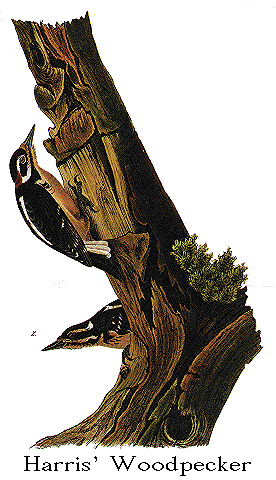Birds of America
By John James Audubon, F. R. SS. L. & E.
VOLUME IV.



Bird Call
Family
Genus

HARRIS' WOODPECKER.
[Hairy Woodpecker (see also Canadian Woodpecker,
Phillips' Woodpecker,
Maria's Woodpecker,
Hairy Woodpecker,
and Audubon's Woodpecker).]
PICUS HARRISII, Aud.
[Picoides villosus.]

PLATE CCLXI.--MALE and FEMALE.
It is to Mr. TOWNSEND that we are indebted for the discovery of this
singularly marked species, of which he has sent me a pair of specimens in
excellent preservation, both shot on the Columbia river, the male on the 18th of
January 1836, the female on the 7th of September 1834. Having been left at
liberty to give names to whatever new species might occur among the birds
transmitted to me by that zealous naturalist, I have honoured the present
Woodpecker with the name of my friend EDWARD HARRIS, Esq., a gentleman to whom I
am most deeply indebted for many acts of kindness and generosity, and in
particular for his efficient aid at a time when, like my predecessor WILSON, I
was reduced to the lowest degree of indigence, and removed from any individuals
to whom I could make known my wants. But, independently of his claim to
scientific recognition as the friend and supporter of one who has devoted his
life to the study of birds, he merits this tribute as an ardent and successful
cultivator of ornithology, and an admirer of the works of Him whose good
providence gave me so noble-hearted a friend.
HARRIS' WOODPECKER, Picus Harrisii, Aud. Orn. Biog., vol. v. p. 191.
Male, 9; wing, 5 2/12.
Columbia river. Rare.
Adult Male.
Bill about the length of the head, straight, strong, angular, compressed
toward the end, which is truncate and cuneate. Upper mandible with the dorsal
line straight, the ridge very narrow, the sides sloping and concave to the
lateral angle, which is nearer the edge, the intervening space nearly erect, the
edges sharp, direct, and overlapping. Lower mandible with the angle short and
of moderate width, the dorsal line straight, the ridge narrow, the sides convex
at the base, sloping outwards and nearly flat, with a faint ridge, above which
they are convex, the edges sharp, the tip truncate. Nostrils oblong, basal,
concealed by the feathers, and placed near the margin.
Head large, ovate; neck rather short; body full. Feet very short; tarsus
short, compressed, feathered anteriorly more than one-third down, scutellate in
the rest of its extent, as well as internally behind; toes four; first small,
fourth longest and directed backwards, second and third united at the base, the
latter not much longer; all scutellate above. Claws large, much curved,
compressed, laterally grooved, very acute.
Plumage very soft, full, and blended. A tuft of recurved stiffish feathers
on each side of the base of the upper mandible, concealing the nostrils. Wings
rather long; the first quill very small, being only an inch and two-twelfths in
length, and two inches and a twelfth shorter than the second, which is
eight-twelfths shorter than the third, the fourth two-twelfths longer than the
latter, but scarcely exceeding the fifth; secondaries broadly rounded, the outer
slightly emarginate. Tail of moderate length, cuneate, of twelve feathers, of
which the latter, which is rounded and unworn, is only ten-twelfths long, the
next, also rounded, an inch and a twelfth shorter than the middle, of which the
shaft terminates so as to leave the tip slit.
Bill bluish-grey, as are the feet; the claws brown. The tufts at the base
of the upper mandible dull yellow, with the tips black; the upper part of the
head glossy black; over each eye is a band of white continuous with a transverse
band of scarlet on the occiput; a black band in the loral space, continued
behind the eye over the auriculars, and joining the black of the hind neck;
beneath this black band is one of white, proceeding from the angle of the mouth
and curving backward below the middle of the neck, but without meeting its
fellow; this band is succeeded by another of black, proceeding from the base of
the lower mandible, and continuous with the black of the hind neck and
shoulders. All the upper parts are black, the quills tinged with brown; but the
feathers along the middle of the back are largely tipped with white; the quills,
excepting the inner three, are marked with small roundish spots, of which there
are five on the outer, and four on the inner web of the four longest quills,
while on the outer there is only an elongated spot on the inner web, and on the
next one spot on the outer and three on the inner. The four middle
tail-feathers are black, the next also black, with a small part of the inner
web, and a large portion of the outer, toward the end, white; the rest white,
with the base black; the outermost small feather almost entirely white. The
lower parts are brownish-white.
Length to end of tail 9 inches; bill along the ridge 1 1/4, along the edge
of lower mandible 1 5/12; wing from flexure 5 2/12; tail 3 1/2, tarsus 10/12;
hind toe 3/12, its claw 3/12; second toe 6/12, its claw 6/12; third toe 7/12,
its claw 7/12; fourth toe 8/12, its claw 7/12.
Adult Female.
The female resembles the male, but wants the red occipital band.









